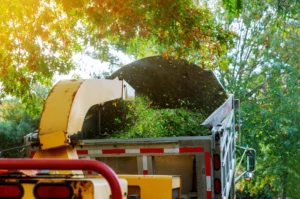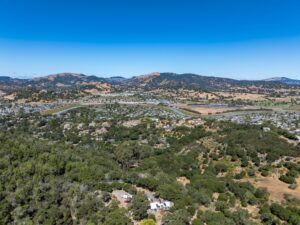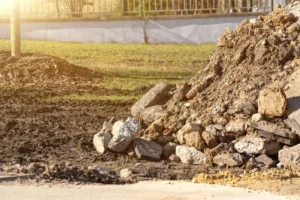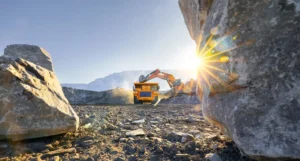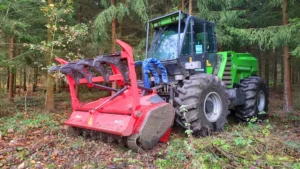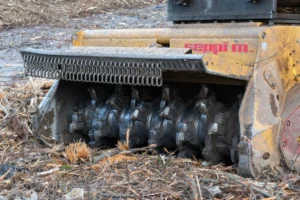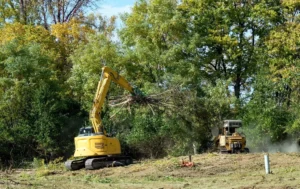Cold changes everything, the oil thickens, seals harden, fibers turn brittle, and what felt smooth in summer can feel sluggish after the first frozen hour. A cold weather mulcher must reach speed without chatter, hold torque when frozen stems push back, and stay warm enough to remain efficient without crossing into heat that cooks seals.
You do not get that balance by wishful thinking, you get it with a plan that fits winter physics. Warm the circuit correctly, size the bite to match frozen fiber, keep airflow honest so heat leaves where it should, and log the numbers that tell you when drift begins.
This guide turns those ideas into specific moves. You will see how oil, pumps, fans, doors, and teeth behave when temperatures drop, how the drive and reliefs should be set for steady winter output, and how operator rhythm keeps the head inside a narrow efficient range from the first pass to the last light.
Winter physics and machine behavior
Cold weather magnifies small mistakes, because heavy oil steals pressure, stiff seals add drag, and brittle fiber punishes aggressive entry. If you try to run winter the way you ran summer, you will fight slow build, sudden stalls, and noisy spin down. The fix begins with a minute by minute warm routine, a conservative bite rule that adapts as the machine reaches its window, and a clean airflow path that keeps cores breathing while snow and fluff try to plug them. Write those rules where crews can see them and enforce them during the pre start brief, then you will feel the cut turn from a fight into a rhythm.
Before you roll into the first row, confirm the plan with a short readiness sequence. Warm to operating temperature, take baseline pressures, make one light pass, then read temperatures again. This is the fastest way to catch drift and to confirm the machine is ready for sustained load in the cold. For a step by step outline that fits this routine into your day, see the winter friendly process in pre operation checks before large scale mulching missions.
Oil viscosity, cavitation risk, and pressure stability in the cold
Hydraulic oil does not behave the same at five degrees as it does at thirty. Viscosity rises, charge flow lags, and the pump sees more restriction on the inlet. If you rush the throttle, the rotor tries to spin faster than the oil can feed, and the motor will complain with a dry, rising whine that hints at cavitation. The goal is steady warm up and steady ramp. Start at low idle, cycle functions slowly, watch charge pressure build, then bring the head up to speed in steps. Hold each step long enough to feel the system settle, then move to the next. When the oil is warm, the head will reach target without chatter, and your first cut will feel smooth instead of ragged.
Pressure stability is your next concern. Cold oil can mask a weak relief or a sticky valve, so check settings at temperature, not at cold idle. Read main pressure, charge pressure, and case drain at the ports. If case drain climbs quickly as the machine warms, a motor may be wearing or a seal may be tight from the cold. Make notes, because trend lines will show truth before a failure does. If numbers differ from your commissioning sheet, correct them now. Later in the day, those small deltas become long stops.
A clean warm routine pays off in more than comfort. A machine that reaches operating window without drama burns less fuel, shakes less hardware, and asks for fewer midday fixes. If crew time is tight, assign the warm sequence to a specific operator and track the minutes until oil stabilizes. Within a week you will know the exact warm time for each carrier and head at your winter temperatures.
Seals, hoses, and breathers under winter load, what fails first and how to prevent it
Cold stiffens elastomers and makes old hoses brittle. The same bend that was fine in August can crack a cover in January. Seals that once conformed now drag, and a hard lip will heat the surface under it. You will feel this as a slight rise in case temperature and as a slow, rough spin down when you stop the rotor. It is tempting to chalk that feeling up to winter, but it is a signal that maintenance must adjust. Inspect every hose that crosses a frame edge or passes near a manifold. Add sleeves where rub points exist. Confirm clamps are positioned correctly. Replace any hose that shows blisters or flat spots. A hose that rubs in the cold will fail sooner than it would in summer.
Breathers matter more in winter. When warm oil cools overnight, the tank inhales. A tired breather will pull frost and fine dust into the system. Swap weak breathers before the season and check that caps seal cleanly. Look at magnetic drain plugs on service, a light fuzz is normal, sharp flakes are not. If flakes appear, extend your inspection, because a cold season is not the time to gamble on marginal hardware. Once you harden this part of the plan, vibration falls, leaks vanish, and operators spend their time cutting instead of hunting a weep that turns into a spray.
When you map your winter prep, tie these checks to a structural mindset. Good steel and good layout keep hoses off sharp edges and keep mounts aligned when cold makes materials move differently. Practical build habits that save you in winter are laid out in our operator guide.
Here is a short seal and hose checklist that fits the season and keeps failures from stealing the afternoon:
- inspect hose routes for tight bends at the motor inlet, open the bends to reduce inlet vacuum in cold conditions
- check clamps for position and tightness, add abrasion sleeves where lines contact brackets or frame members
- replace breathers that show restriction, confirm tank caps seal, and wipe frost from vents before start
Run these checks during the pre start window, not after the first stall. In winter, prevention is the cheapest uptime you can buy.
Combustion, cooling, and fan control when the air is cold and dense
Cold air is dense, which helps combustion and can make the engine feel stronger on throttle, but it also steals heat faster from the oil and from the cores. That means a winter carrier can be over cooled on the engine side while the hydraulic side runs hot if airflow is blocked by snow, fluff, or ice on the screens. Your job is to manage both without letting either dictate a bad pattern. Use manual fan reversals early in the shift, not only when the gauge climbs. Short pulses keep cores open and avoid deep packed mats that demand long, high draw clean cycles. Deep reversals draw fuel and pull time. Short, frequent pulses are cheaper.
Ducting should be straight and sealed. If a foam strip is missing, replace it. A small gap lets cold air bypass the core, which forces fans to stay on and keeps the oil too cool early, then too hot later. Watch trend rate, not only peak numbers. A fast rise after a pass means airflow is falling. Slow the feed, pulse the fan, and clear the screen. After you do, look at the stream. Clean, short throw means your door and curtains are doing their job and not loading the fan with stray discharge.
Fuel use and heat behavior are connected. When fans spend fewer minutes at full draw, gallons per hour fall. If your crew needs a quick set of habits that link airflow to fuel instead of treating them as separate issues, build them from the guidance in heavy duty mulcher durability: engineering secrets. That way, the same cleanout rhythm that protects cores also cuts burn rate.
Setup and configuration for steady winter output

Good winter performance is a configuration problem as much as it is a driving problem. The same head can feel heavy and hot or light and calm depending on ratio, reliefs, tooth style, and door angle. In cold conditions you want predictable build, smooth recovery, and chip control that avoids long throw. That means you do not chase speed, you shape the load. Set reliefs to the warm window, pick a tooth that slices rather than grabs, shorten throw near public edges, and size the bite so the rotor lives in its efficient band without cycling into relief.
Drive layout matters too. A belt stage can absorb a sudden frozen shock if tension is correct, a direct motor can feel crisp once oil is warm, a gearbox can pair a compact motor with the torque you need. Each path has its own winter personality.
Relief settings, ratio choice, and warm window targeting for the drive
Relief settings should be confirmed at temperature, not cold. A relief that seems fine in the yard can sit low after thirty minutes of work, which forces the system to dump when the head meets a frozen clump. Dumping is waste. It turns diesel into heat and momentum into frustration. Warm the oil, then set main pressure, charge makeup, and any anti cavitation checks so the motor stays in its safe zone under a modest bite. Note the exact numbers in the cab and compare them after the first row. If numbers drift, adjust before lunch.
Ratio choice is your next lever. A tall ratio that feels fast in clean summer wood can feel sluggish in winter. The rotor will take longer to reach speed and will be easier to stall. Consider a slightly shorter ratio for winter blocks, or hold the ratio and size the bite down a step for the first hour. The point is not to cut slower, it is to keep the rotor in its efficient band without cycling into relief. That is how you keep temperatures flat and gallons down.
When this tuning is right, the machine builds speed smoothly, holds it, and responds to a small bite increase without drama. If you want an at a glance reminder that lists the three numbers that matter, write them on a small card and tape it by the test ports, main pressure, charge, and case drain. Then your crew has a shared target and your winter window stays steady all day.
Tooth selection, door angle, and frozen fiber, how to slice instead of pound
Frozen stems can be deceptive. They break clean when thin, then grab when a pocket of ice or grit appears. Your attachment must respect that. Choose a tooth that presents a clean cutting edge at a conservative angle. Sharp steel shines in clean frozen timber if you accept a shorter life, while carbide survives contact with grit but needs a steady hand so the edge does not chip. Positive lock retention is non negotiable. A tooth that moves under shock will change angle, start a vibration, and cook a seal before you notice.
Door angle and curtain shape control throw. In cold air, chips travel farther. Shorten throw near roads and paths. Keep chips down inside your lane and you will save time on cleanup and keep the fan from fighting stray debris.
If you need a detailed, vegetation first way to pick the right attachment set for the day, pull the field rules in choosing the right attachment for vegetation type into your winter plan.
Here is a simple frozen fiber setup list you can keep in the cab:
- pick a tooth that slices, not one that hooks, and mark torque so drift is obvious at the first pause
- set a conservative door angle near public edges, lengthen throw only in clean open ground when you are sure of the wind
- write a thin bite rule for the first hour, increase one step only when the chip stream stays smooth after a full pass
These moves protect the drive, keep the rotor calm, and prevent the long, hot minutes that come from overfeeding frozen wood.
Airflow, screens, and staged cleanouts when snow and fluff try to win
Snow and seed fluff act like glue on a warm core. If you wait for the gauge to climb before you clean, you are already late. Stage a short cleanout near the end of the first block, then another after lunch. Keep screens that hinge or slide without tools, and confirm seals fit tight so cold air does not bypass the core. Use manual reversals early and often. Short pulses prevent deep mats and keep fan draw low. Deep mats demand long reversals that burn time and fuel.
Ducting must be straight with no hidden corners where ice can form. After a cold night, open the pack and check for frost sheets that block flow even when the screen looks clear. They melt into trouble when you are in the row. When you clear screens, watch where chips fall. If the throw arcs into the pack during a turn, adjust door angle or your turn path. This is a pattern detail, not only a maintenance detail, and it saves you both heat and minutes.
If your winter calendar includes roadside work with plowed snow, set a rule that keeps discharge inside the buffer and reduces throw near traffic. Practical pass and edge habits for public interfaces are captured in roadside and railway clearing. Bring those habits into your winter plan so pattern and airflow support each other.
Operator method and pattern adjustments in winter

Winter operators do not wrestle the machine to get acres. They respect the window and use the pattern to keep the head inside it. That means steady entry, consistent bite, short throw, and timely cleanouts. The machine will tell you when you are inside the range, the chip stream stays tight and even, the tone stays calm, and the gauges move slowly rather than in spikes. Your job is to hold that range and to write short rules that keep every operator in sync, even when wind, slope, and visibility change.
Communication makes this easier. A two minute pre start brief sets the bite, the overlap, the door angle, the warm time, and who calls the first cleanout. Mid shift, read the log, compare rise rates, and adjust rules before the afternoon heat builds. End of shift, write one sentence about what slowed the work and one sentence about what made it smooth. Patterns become training when you write them down.
Warm routine, bite staging, and recovery moves that protect fuel and speed
A good warm routine is the foundation for winter output. Start with low idle, cycle functions slowly, watch charge pressure reach the target, then bring the rotor up in steps. Hold each step, listen for whine, and feel for vibration. Once warm, set a thin bite for the first full pass. If the chip stream stays smooth and the tone stays flat, increase one step on the next row. If the stream lifts or thins, stay where you are. The goal is not to prove a point, it is to lock a rhythm that the machine can hold without spikes.
Recovery moves are your second tool. When the head grabs, do not ram the throttle. Lift gently, shorten the bite, re enter at a lower angle, and let the rotor recover. This keeps you off the reliefs and keeps gallons per hour in check. Once you pick up the rhythm again, your pattern will carry you. If this sounds familiar, it is because the same logic drives fuel control in every season.
The details are gathered in heavy duty mulcher fuel efficiency, 7 proven tips. Use that guide to coach operators who are new to winter.
Snow, ice, visibility, and public edges, how to keep control without losing pace
Snow and ice hide hazards and change chip behavior. Visibility drops, chips travel farther, and your edges demand more discipline. Set a conservative door angle near roads and paths. Keep throw down inside your lane. Clean work lights and camera lenses at each pit stop. Confirm wipers work and blades do not streak. A clean view lets you hold the pattern without guessing at shapes in the snow.
Edges create rules. Shorten bite near signs and posts, step the pattern to avoid crowding the door at the edge, and plan returns that do not drive across packed discharge. Slow is faster here. The time you save by forcing a long throw will be paid back on cleanup. Teach operators to watch chip color too. Dark chips can signal dirt or hidden metal. If the color shifts, pause and inspect before you feed the hazard into the head.
Here is a quick winter edge checklist that fits a pocket and keeps the row clean:
- wipe lights and lenses at each stop, confirm a clear view before the next entry
- shorten bite near public edges, keep discharge inside the buffer, and avoid crowding the door
- watch chip color for signs of dirt or metal, pause and inspect before damage happens
These small moves turn a risky edge into a predictable part of the pattern and protect both the public and the machine.
Storm debris, drift piles, and recovery work after winter events
After a storm, the ground is littered with broken limbs, wire, and hidden metal. Your winter plan must adapt to recovery work. Begin with a slow survey. Mark hazards. Set a defensive attachment, a tooth that survives grit and a lock that resists spin. Enter with a thin bite, let chips fall short, and avoid flicking discharge toward traffic or fences. Run a cleanout earlier than usual. Drifted material packs screens faster than a clean stand.
In these conditions, production is still about rhythm, not about hero moves. Finish a pocket fully before you move. Do not weave through hazards and leave islands behind you. A completed pocket means fewer returns and less re cut.
After each pocket, read temperatures and case lines, then write the numbers. Trend lines show you which sites are loading the machine and where to add another cleanout.
If storm response is part of your winter schedule, align your patterns and attachment choices with the practical cautions in storm cleanup. This keeps safety, output, and machine health aligned when the ground is at its worst.
“Winter output is not magic, it is a window, warm until the oil flows, slice instead of pound, keep air moving, and write the numbers, do that and power stays where you need it.”
Get a cold weather plan that fits your machines
Cold weather mulcher work rewards teams that write their rules and follow them. The fastest way to lock those rules is a one page winter plan for the cab.
We will build yours around your carrier and head, your typical temperatures, and your sites. It will include a warm routine, relief targets at temperature, a frozen fiber bite rule, a door angle for public edges, and a staged cleanout schedule.
It will also include a short log that captures pressure, temperature, and case drain, so trends guide the day rather than surprises. If you want a plan that fits your machines and your season, you may want to reach out to us.
We will map your goals and your ground to a clear winter rhythm, then your crews can turn cold mornings into steady production without the power loss that usually steals the afternoon.


